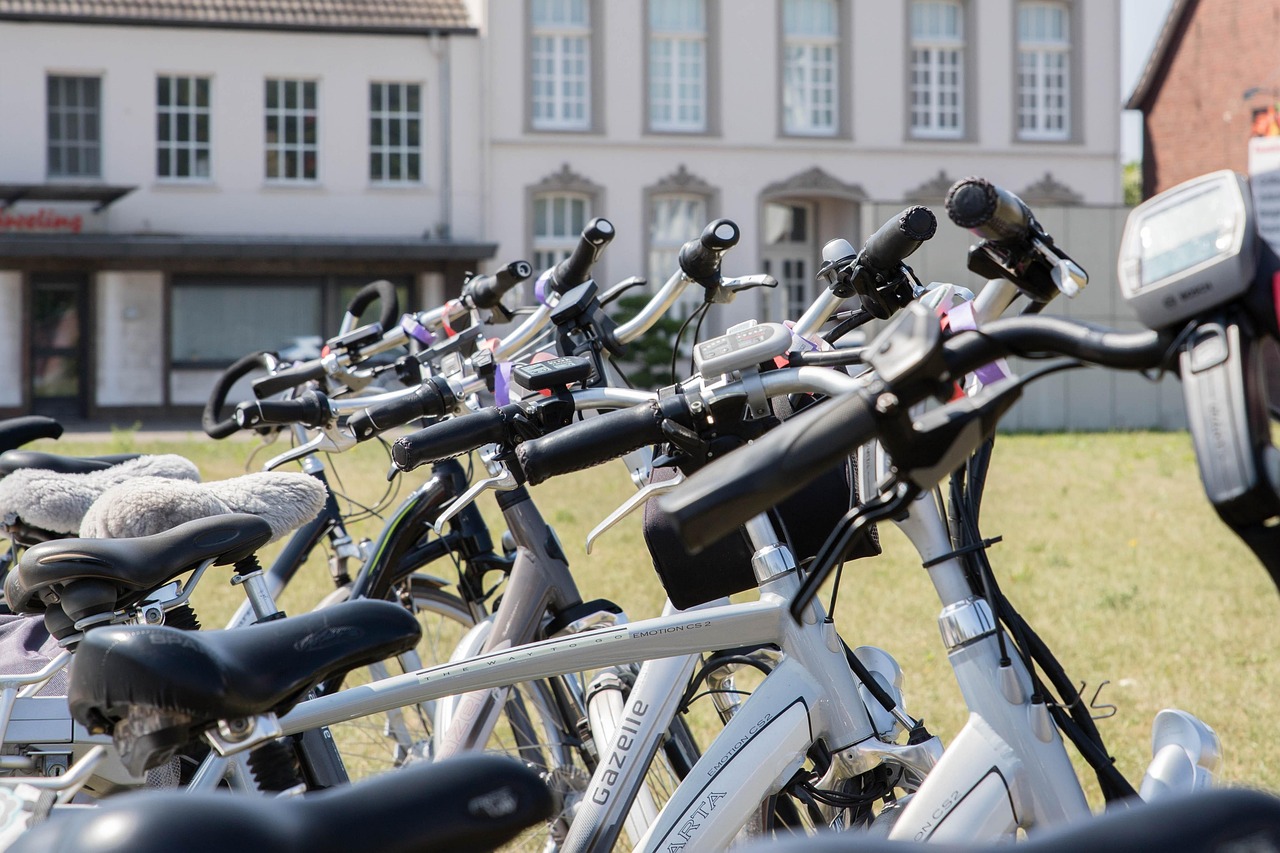This article delves into the numerous advantages that electric bikes offer to commuters in 2025, emphasizing their positive effects on health, the environment, and urban mobility.
1. Environmental Impact of Electric Bikes
Electric bikes are a sustainable transportation option that significantly reduce carbon emissions compared to traditional vehicles. As cities become more congested, the shift towards electric bikes is essential for eco-conscious commuters aiming to minimize their environmental footprint.
2. Health Benefits of Riding Electric Bikes
- Riding electric bikes promotes physical fitness, allowing commuters to stay active while enjoying the convenience of assisted pedaling.
- Cardiovascular Health: Regular cycling enhances cardiovascular health, lowering the risk of heart disease.
- Mental Health Benefits: Cycling can alleviate stress and anxiety, providing mental health benefits through physical activity.
3. Cost-Effectiveness of Electric Bikes
Electric bikes are a financially savvy choice for commuters, saving money on fuel, parking, and maintenance. Investing in an electric bike can lead to substantial long-term savings compared to car ownership.
4. Convenience and Flexibility
- Electric bikes offer unmatched convenience, allowing riders to navigate traffic and find parking easily.
- They enable commuters to avoid traffic jams, resulting in quicker travel times.
5. Enhanced Commuting Experience
Electric bikes provide a more enjoyable commuting experience, combining speed, comfort, and fun for daily travelers. Many models come equipped with features that enhance comfort, such as adjustable seats and ergonomic designs.
6. Safety Considerations for Electric Bike Commuters
Safety is crucial for electric bike users. Wearing appropriate protective gear, such as helmets and reflective clothing, is essential for safe riding. Commuters should also familiarize themselves with local regulations regarding electric bike usage.
7. Community and Social Benefits
Electric bikes can foster community connections, encouraging social interaction among commuters and supporting local businesses. Cycling creates opportunities for networking and contributes to economic growth.
8. Future Trends in Electric Biking
The electric bike market is evolving, with advancements in battery technology and smart features enhancing performance. Cities are increasingly investing in bike-friendly infrastructure, making electric biking a more viable commuting option.
9. Conclusion: The Future of Commuting with Electric Bikes
Electric bikes represent a sustainable, cost-effective, and enjoyable commuting option, making them integral to urban mobility in 2025 and beyond.

1. Environmental Impact of Electric Bikes
Electric bikes, or e-bikes, are revolutionizing the way we think about transportation, particularly in urban environments. One of the most significant advantages of e-bikes is their substantial reduction in carbon emissions when compared to traditional gasoline-powered vehicles. This reduction is crucial in the fight against climate change, as transportation is a major contributor to global greenhouse gas emissions.
Unlike cars, which emit a considerable amount of CO2 per mile traveled, e-bikes operate on electricity, which can be sourced from renewable energy. This means that, depending on the energy mix of the electricity grid, the carbon footprint of riding an e-bike can be dramatically lower. For instance, studies show that e-bikes can produce up to 90% less carbon emissions than conventional cars over the same distance.
Moreover, the adoption of electric bikes can lead to a decrease in traffic congestion and the associated emissions from idling vehicles. As more commuters opt for e-bikes instead of cars, cities can experience improved air quality and a reduction in noise pollution, contributing to healthier urban environments.
In addition to their direct environmental benefits, electric bikes encourage a shift in public perception about sustainable transportation. As people become more aware of the advantages of using e-bikes, there is a greater likelihood of supporting policies and infrastructure that favor green transportation solutions. This can include the development of dedicated bike lanes, charging stations, and incentives for e-bike users.
| Benefit | Impact |
|---|---|
| Reduced Carbon Emissions | Up to 90% less than cars |
| Improved Air Quality | Less pollution from vehicles |
| Encouragement of Sustainable Practices | Support for green policies and infrastructure |
In conclusion, electric bikes represent a sustainable choice for eco-conscious commuters. Their ability to significantly lower carbon emissions while promoting healthier urban living makes them an essential component of the future of transportation.

2. Health Benefits of Riding Electric Bikes
Health Benefits of Riding Electric Bikes
Riding electric bikes (e-bikes) offers a multitude of health benefits that can significantly enhance the overall well-being of commuters. While traditional biking is known for its advantages, e-bikes take it a step further by providing an option that combines exercise with the convenience of assisted pedaling. This unique feature allows riders to engage in physical activity without the intimidation that often accompanies strenuous cycling.
1. Promoting Regular Exercise
One of the most notable benefits of riding e-bikes is their ability to encourage regular exercise. With the assistance of electric motors, riders can tackle longer distances and steeper inclines with ease. This means that even those who may not consider themselves athletic can comfortably incorporate cycling into their daily routine, leading to increased physical activity.
2. Cardiovascular Health
- Regular cycling, whether on a traditional bike or an e-bike, improves cardiovascular health. It strengthens the heart, lowers blood pressure, and enhances circulation.
- Studies indicate that consistent cycling can reduce the risk of heart disease by promoting better heart function and reducing cholesterol levels.
3. Weight Management
Electric bikes are effective tools for weight management. Riders can burn calories while enjoying the ride, making it easier to maintain or lose weight. The added assistance allows for longer rides, which can further amplify calorie expenditure.
4. Mental Health Benefits
Engaging in outdoor activities like cycling can significantly boost mental health. The combination of physical exercise and exposure to nature helps alleviate stress and anxiety. Furthermore, the joy of riding can lead to improved mood and overall mental well-being.
5. Social Interaction
Riding e-bikes can also foster social connections. Joining cycling groups or participating in community rides provides opportunities for social interaction, which is essential for emotional health.
In conclusion, the health benefits of riding electric bikes are numerous and impactful. From promoting regular exercise to enhancing mental well-being, e-bikes serve as a valuable tool for those looking to improve their health while enjoying the convenience of modern commuting.
2.1 Cardiovascular Health
Cardiovascular health is a critical aspect of overall well-being, and engaging in regular cycling can significantly enhance this vital area of health. Cycling, whether on traditional or electric bikes, acts as a powerful exercise that positively impacts the heart and circulatory system.
When you cycle regularly, your heart becomes stronger and more efficient at pumping blood, which helps in lowering blood pressure and improving circulation. This not only reduces the risk of heart disease but also contributes to better overall health. Additionally, the rhythmic nature of cycling helps to regulate heart rate and can lead to improved heart function over time.
- Improved Blood Flow: Regular cycling enhances blood flow, which is essential for delivering oxygen and nutrients to vital organs.
- Cholesterol Management: Engaging in cycling can help lower levels of bad cholesterol (LDL) while increasing good cholesterol (HDL), promoting a healthier lipid profile.
- Weight Control: Maintaining a healthy weight is crucial for cardiovascular health. Cycling is an effective way to burn calories and manage body weight.
Moreover, cycling is a low-impact exercise, making it accessible for people of all ages and fitness levels. This means that even those with joint issues or physical limitations can still benefit from the cardiovascular advantages of cycling.
Incorporating cycling into your daily routine can also lead to enhanced mental well-being. The release of endorphins during physical activity can reduce stress and anxiety, further supporting heart health. Studies have shown that individuals who cycle regularly report feeling more energized and less fatigued, contributing to a more active lifestyle.
In summary, regular cycling is an excellent way to improve cardiovascular health. By enhancing heart function, managing weight, and promoting mental well-being, cycling serves as a comprehensive approach to achieving and maintaining a healthy heart.
2.1.1 Improved Lung Function
Improved Lung Function is a significant benefit of cycling, particularly when considering its impact on overall respiratory health. Engaging in regular cycling activities can lead to enhanced lung capacity and function, which are crucial for maintaining a healthy lifestyle.
When you cycle, your body requires more oxygen to fuel your muscles, which stimulates your lungs to work more efficiently. Over time, this increased demand for oxygen helps to strengthen the respiratory muscles, leading to improved lung function. Here are some key points to consider:
- Increased Lung Capacity: Regular cycling can expand the lungs’ capacity, allowing for greater oxygen intake. This is particularly beneficial for individuals with respiratory conditions.
- Enhanced Respiratory Efficiency: Cycling promotes better oxygen exchange in the lungs, which can improve overall endurance and stamina.
- Reduced Risk of Respiratory Issues: Engaging in aerobic activities like cycling can lower the risk of developing respiratory diseases, such as asthma or chronic obstructive pulmonary disease (COPD).
- Strengthened Immune System: Improved lung function contributes to a stronger immune response, helping the body fend off illnesses more effectively.
Moreover, cycling outdoors exposes individuals to fresh air, which can further enhance lung health. The combination of physical activity and clean air can lead to a notable improvement in respiratory function.
Incorporating cycling into your routine not only benefits lung health but also contributes to overall well-being. Whether commuting to work or enjoying leisure rides, the positive effects on lung function are undeniable. Embrace cycling as a means to enhance your respiratory health and enjoy a more active lifestyle.
2.1.2 Weight Management
Weight Management with Electric Bikes has become an increasingly popular topic as more individuals seek effective ways to maintain or lose weight. Electric bikes, often referred to as e-bikes, provide a unique blend of exercise and convenience that appeals to a wide range of users.
One of the primary advantages of riding an electric bike is its ability to burn calories effectively. Unlike traditional bicycles, e-bikes offer varying levels of pedal assistance, allowing riders to adjust the intensity of their workout based on their fitness levels and goals. This adaptability makes it easier for users to engage in physical activity, regardless of their starting point.
- Calorie Burning: Studies indicate that riding an electric bike can help users burn between 300 to 600 calories per hour, depending on the level of assistance used and the rider’s weight.
- Increased Duration: The assistance provided by e-bikes enables riders to cycle longer distances, which can lead to greater overall calorie expenditure compared to traditional cycling.
- Low-Impact Exercise: E-bikes offer a low-impact workout option, making them suitable for individuals with joint issues or those who may find high-impact exercises challenging.
Moreover, electric bikes encourage a more active lifestyle. Many users find that they are more likely to choose cycling over driving for short trips, leading to increased physical activity throughout the day. This shift not only aids in weight management but also contributes to improved cardiovascular health and overall well-being.
In conclusion, electric bikes serve as an excellent tool for weight management by effectively burning calories while providing a fun and enjoyable mode of transportation. As more individuals embrace this innovative cycling option, the benefits for both personal health and environmental sustainability become increasingly evident.
2.2 Mental Health Benefits
Cycling is not just a mode of transportation; it is also a powerful tool for enhancing mental health. Engaging in regular cycling can lead to significant reductions in stress and anxiety, providing a myriad of mental health benefits through the combination of physical activity and exposure to the great outdoors.
When you cycle, your body releases endorphins, often referred to as the “feel-good hormones.” These natural chemicals can help elevate your mood and create a sense of well-being. Moreover, the rhythmic nature of cycling can be meditative, allowing you to clear your mind and focus on the present moment, which is essential for reducing feelings of anxiety.
Additionally, cycling outdoors exposes you to natural light, which can boost your serotonin levels and improve your mood. This exposure to sunlight is particularly beneficial during the winter months when Seasonal Affective Disorder (SAD) can affect many individuals. The combination of physical activity and sunlight can help combat these feelings of sadness and lethargy.
| Benefits of Cycling for Mental Health | Description |
|---|---|
| Reduces Stress | Cycling helps alleviate stress by promoting relaxation and providing a break from daily pressures. |
| Enhances Mood | Regular cycling can lead to improved mood due to the release of endorphins. |
| Boosts Confidence | Achieving cycling goals can enhance self-esteem and personal satisfaction. |
| Encourages Social Interaction | Cycling can be a social activity, fostering connections with others. |
In conclusion, the mental health benefits of cycling are profound. By incorporating cycling into your routine, you can not only improve your physical fitness but also enhance your overall mental well-being. Whether you ride alone or with friends, cycling offers a unique combination of physical activity and nature that can help you manage stress and anxiety effectively.

3. Cost-Effectiveness of Electric Bikes
Cost-Effectiveness of Electric Bikes
In today’s fast-paced world, electric bikes have emerged as a cost-effective transportation solution for commuters. The financial benefits of using electric bikes extend beyond mere savings on fuel; they encompass various aspects of commuting costs.
- Fuel Savings: One of the most significant advantages of electric bikes is the elimination of fuel expenses. Commuters can save a substantial amount on gas, especially in urban areas where fuel prices can be high.
- Parking Costs: Finding parking in busy city centers can be both challenging and expensive. Electric bike riders can often park for free or at a fraction of the cost of traditional vehicles, leading to further savings.
- Maintenance Expenses: Electric bikes generally require less maintenance than cars. With fewer moving parts and no need for oil changes, the long-term maintenance costs are significantly lower, making them an attractive option for budget-conscious commuters.
Moreover, the initial investment in an electric bike can be recouped over time through these savings. Long-term financial planning shows that many commuters can save thousands of dollars annually by switching from a car to an electric bike.
| Expense Type | Traditional Vehicle | Electric Bike |
|---|---|---|
| Fuel Costs (Annual) | $1,500 | $200 |
| Parking Fees (Annual) | $600 | $0 |
| Maintenance Costs (Annual) | $800 | $150 |
| Total Annual Savings | $2,900 | — |
In conclusion, the cost-effectiveness of electric bikes makes them a viable and financially savvy choice for commuters. By reducing fuel, parking, and maintenance expenses, electric bikes not only promote a sustainable lifestyle but also contribute to significant savings over time.
3.1 Long-Term Savings
Investing in an electric bike is not just a trendy choice; it can lead to substantial long-term savings when compared to traditional car ownership. The costs associated with owning a car can quickly add up, including fuel, insurance, maintenance, and parking fees. In contrast, electric bikes offer a more economical alternative that can significantly reduce these expenses.
| Expense Category | Car Ownership | Electric Bike Ownership |
|---|---|---|
| Fuel Costs | $1,500/year | $100/year (electricity) |
| Insurance | $1,200/year | $100/year |
| Maintenance | $500/year | $100/year |
| Parking Fees | $300/year | $0 |
| Total Annual Costs | $3,500 | $300 |
As illustrated in the table above, the annual savings can be significant. By switching to an electric bike, commuters can save over $3,200 annually. These savings can be redirected towards other important expenses or investments, enhancing financial stability.
Moreover, electric bikes require minimal maintenance compared to cars. With fewer moving parts and no need for oil changes or complex repairs, the long-term maintenance costs are greatly reduced. This simplicity not only saves money but also time, allowing riders to focus on their journeys instead of vehicle upkeep.
In addition to direct savings, electric bikes can also contribute to lower healthcare costs by promoting a healthier lifestyle. Regular physical activity helps prevent chronic diseases, which can lead to lower medical expenses over time. Thus, the financial benefits of investing in an electric bike extend beyond immediate savings, creating a holistic financial advantage for users.
In conclusion, the financial implications of choosing an electric bike over a car are clear. With lower operational costs, reduced maintenance, and potential health benefits, electric bikes emerge as a smart investment for commuters looking to save money in the long run.
3.2 Reduced Commuting Costs
In today’s fast-paced world, commuters are constantly seeking ways to minimize their daily expenses. One of the most effective methods is by utilizing electric bikes. These innovative vehicles not only provide a fun and eco-friendly means of transportation but also significantly reduce commuting costs in various ways.
- Fuel Savings: Traditional vehicles consume fuel, which can be a substantial expense. By switching to an electric bike, commuters eliminate the need for gas, leading to considerable savings over time.
- Public Transport Fares: Many individuals rely on buses or trains for their daily commute. Electric bikes offer a cost-effective alternative, allowing users to avoid the recurring expenses associated with public transportation.
- Maintenance Costs: Electric bikes generally require less maintenance than cars. With fewer moving parts and no need for oil changes, the overall maintenance costs are significantly lower, which can further enhance savings.
- Parking Fees: Finding parking can be a hassle and often comes with fees. Electric bikes can be parked in smaller spaces, reducing the need for expensive parking solutions. This convenience translates into more savings for commuters.
Moreover, the initial investment in an electric bike can quickly pay off through these various savings. As urban areas continue to grow and traffic congestion increases, the financial benefits of using electric bikes become even more apparent. Commuters can enjoy the freedom of movement without the burden of high costs.
In conclusion, by choosing electric bikes, commuters not only contribute to a healthier environment but also experience a significant reduction in their commuting costs. This dual benefit makes electric bikes a practical solution for modern transportation challenges.

4. Convenience and Flexibility
In the bustling environment of urban life, electric bikes have emerged as a game-changer for commuters. They offer a level of convenience that traditional vehicles simply cannot match. With the ability to navigate through traffic effortlessly, riders can enjoy a smoother journey, avoiding the frustrations of gridlock.
One of the most significant advantages of electric bikes is their ability to avoid traffic jams. Unlike cars, which are often stuck in long lines of vehicles, electric bike riders can take alternative routes, utilizing bike lanes and shortcuts that are inaccessible to larger vehicles. This not only reduces travel time but also enhances the overall commuting experience.
Moreover, finding parking is another hassle that electric bike users can easily sidestep. Many urban areas struggle with limited parking spaces, leading to additional stress for drivers. In contrast, electric bikes can be parked in smaller spaces and often do not require a parking fee. This feature is particularly beneficial for those living in densely populated cities where parking is at a premium.
Additionally, the storage solutions for electric bikes are designed with urban living in mind. Many models are lightweight and foldable, making them easy to carry into buildings or store in small apartments. This flexibility is ideal for commuters who may need to bring their bikes indoors for security or convenience.
In summary, the convenience and flexibility offered by electric bikes make them an attractive option for urban commuters. With the ability to navigate traffic, find parking easily, and store bikes conveniently, electric bikes are redefining how we approach daily commutes.
4.1 Avoiding Traffic Jams
Electric bikes have revolutionized the way commuters navigate urban environments, particularly when it comes to avoiding traffic jams. In today’s fast-paced world, where time is of the essence, electric bikes offer a solution that traditional vehicles cannot match.
One of the most significant advantages of electric bikes is their ability to bypass congested roadways. Commuters can effortlessly weave through traffic, utilizing bike lanes and shortcuts that are often inaccessible to cars. This not only leads to quicker travel times but also reduces the frustration associated with being stuck in traffic. Imagine starting your day without the stress of gridlock—electric bikes make this possible.
Moreover, the flexibility of electric bikes allows for alternative routes that can save time. Unlike cars, which are often limited to main roads, cyclists can explore side streets and paths that may be less crowded. This adaptability not only expedites the journey but also offers a more scenic and enjoyable ride.
Additionally, electric bikes contribute to a healthier lifestyle. While they provide the option of assisted pedaling, riders still engage in physical activity, promoting fitness and well-being. This dual benefit of saving time and enhancing health is a compelling reason for many commuters to make the switch.
In conclusion, electric bikes are not just a mode of transportation; they represent a shift towards smarter commuting. By avoiding traffic jams, they allow riders to reach their destinations faster and with less stress, making them an invaluable asset for urban commuters.
4.2 Easy Storage Solutions
Easy Storage Solutions for Electric Bikes
In today’s fast-paced urban environment, space is often at a premium. Many commuters are seeking efficient ways to store their electric bikes without sacrificing valuable living space. Fortunately, numerous electric bike models are designed with compactness and portability in mind, making them the ideal choice for urban dwellers.
Electric bikes often feature foldable designs, allowing users to easily collapse their bikes into a more manageable size. This feature is particularly beneficial for those living in apartments or homes with limited storage options. By simply folding the bike, it can be tucked away in a closet or under a desk, freeing up essential space.
Additionally, many electric bikes come equipped with removable batteries. This not only makes charging more convenient but also allows users to store the bike without worrying about the battery taking up space. Riders can easily detach the battery and charge it indoors, while the bike itself can be parked securely in a designated area.
Another innovative solution is the use of wall mounts and bike racks. These accessories are designed to hold electric bikes vertically, which significantly reduces the floor space required for storage. By utilizing vertical space, urban commuters can maximize their living areas while keeping their bikes secure and accessible.
Finally, electric bike manufacturers are increasingly focusing on lightweight materials and streamlined designs. A lighter bike is easier to maneuver and store, making it an excellent choice for those who need to frequently transport it or find storage solutions.
In conclusion, the emphasis on easy storage solutions in electric bike design not only caters to the needs of urban commuters but also enhances the overall ownership experience. As cities continue to grow and living spaces shrink, the adaptability of electric bikes will play a crucial role in promoting sustainable transportation.

5. Enhanced Commuting Experience
Enhanced Commuting Experience with Electric Bikes
In the fast-paced world of 2025, commuters are increasingly seeking efficient and enjoyable modes of transportation. Electric bikes (e-bikes) have emerged as a popular choice, providing a unique blend of speed, comfort, and fun for daily travelers. This section delves into how electric bikes enhance the commuting experience.
- Comfort Features: Modern electric bikes are designed with rider comfort in mind. Features such as adjustable seats, shock-absorbing frames, and ergonomic grips ensure that commuters can travel longer distances without discomfort.
- Customizable Options: Many e-bikes offer a range of customizable features, allowing riders to tailor their bikes to their preferences. Options such as handlebar height, seat padding, and color schemes enhance the personal connection between the rider and their bike.
- Speed and Efficiency: With electric assistance, riders can achieve higher speeds with less effort. This means that commuters can arrive at their destinations faster, making electric bikes a time-saving alternative to traditional bicycles and cars.
- Fun Factor: Riding an electric bike is not just about getting from point A to point B; it’s also about enjoying the journey. The thrill of riding at speed, combined with the breeze and the sights of the city, makes commuting a pleasurable experience.
In conclusion, electric bikes significantly enhance the commuting experience by offering features that prioritize comfort and enjoyment. As urban areas continue to evolve, the integration of e-bikes into daily travel will likely become even more prevalent, making commuting not just a necessity, but a delightful part of everyday life.
5.1 Comfort Features
Comfort Features of Modern Electric Bikes
In today’s fast-paced world, commuting can often be a stressful experience. However, modern electric bikes are designed to enhance the comfort of riders, making daily travel not only efficient but also enjoyable. With a variety of features tailored to the needs of commuters, these bikes are revolutionizing the way we think about urban mobility.
- Adjustable Seats: One of the standout features of modern electric bikes is the adjustable seat. Riders can customize the height and angle of the seat to find their perfect riding position, which helps reduce strain on the back and legs during longer journeys.
- Ergonomic Designs: Many electric bikes are crafted with ergonomic designs that promote a natural riding posture. This reduces fatigue and discomfort, allowing riders to enjoy longer rides without the usual aches associated with biking.
- Suspension Systems: Advanced suspension systems are often integrated into electric bikes, providing a smoother ride over rough terrain. This feature absorbs shocks and bumps, ensuring that the commuter feels less impact from uneven surfaces.
- Handlebar Adjustability: Similar to the seats, handlebars on many electric bikes can be adjusted for height and angle. This customization allows riders to maintain a comfortable grip and posture, further enhancing the overall riding experience.
- Built-in Storage: Many modern electric bikes come with built-in storage solutions, such as baskets or rear racks. This feature allows commuters to carry personal items, groceries, or work supplies without compromising comfort.
By incorporating these comfort features, electric bikes cater to a wide range of riders, from casual cyclists to daily commuters. The combination of adjustable components, ergonomic designs, and added conveniences makes them a top choice for anyone looking to enhance their commuting experience.
5.2 Customizable Options
Customizable Options in electric bikes have become a significant trend, allowing riders to personalize their bikes according to their unique preferences and needs. This feature not only enhances the riding experience but also ensures that each commuter can adapt their bike for optimal performance and comfort.
Many manufacturers now offer a range of customization options that cater to different riding styles and conditions. Here are some key areas where riders can make adjustments:
- Frame Size and Design: Riders can select from various frame sizes and designs to ensure a perfect fit. This is crucial for comfort during long rides.
- Battery Capacity: Depending on the distance of daily commutes, users can choose batteries with varying capacities, allowing for longer rides without the need for frequent recharging.
- Motor Power: Different motor options can be selected based on terrain and riding style. For instance, a more powerful motor is ideal for hilly areas.
- Accessories: Riders can add accessories such as fenders, racks, and lights to enhance functionality and safety.
- Color and Aesthetics: Personalizing the color and design of the bike can reflect the rider’s personality, making the bike truly their own.
Additionally, many electric bikes come equipped with smart technology that allows for further customization. Riders can adjust settings via mobile apps, changing parameters like power assist levels and tracking performance metrics.
In summary, the customizable options available in electric bikes not only cater to individual preferences but also enhance overall performance and comfort, making them an attractive choice for commuters. This adaptability is a key factor driving the popularity of electric bikes in urban settings.

6. Safety Considerations for Electric Bike Commuters
Safety is paramount for electric bike users, and understanding safety measures can significantly enhance the commuting experience. As the popularity of electric bikes continues to rise, ensuring the safety of riders is crucial for both personal well-being and public awareness.
Commuters should prioritize protective gear to minimize the risk of injury. Wearing a high-quality helmet is essential, as it can greatly reduce the severity of head injuries in the event of an accident. Additionally, reflective clothing can improve visibility, especially during low-light conditions, making it easier for motorists to see cyclists.
Another important aspect of safety is understanding local laws regarding electric bike usage. Each region has its own regulations concerning where and how electric bikes can be ridden. Commuters should familiarize themselves with these laws to ensure compliance and enhance their safety on the road.
- Know Your Route: Planning your route in advance can help avoid high-traffic areas and potential hazards.
- Use Bike Lanes: Whenever possible, utilize designated bike lanes to ensure a safer riding experience.
- Stay Alert: Always be aware of your surroundings, including pedestrians, vehicles, and road conditions.
Moreover, investing in a quality electric bike equipped with advanced safety features can further enhance rider protection. Features such as anti-lock brakes, integrated lights, and horn systems can provide additional safety measures for commuters.
In conclusion, prioritizing safety is vital for electric bike commuters. By wearing proper gear, understanding local regulations, and being proactive about safety measures, riders can enjoy a more secure and enjoyable commuting experience.
6.1 Protective Gear
Protective Gear: A Key Component for Safe Electric Bike Riding
When it comes to riding electric bikes, wearing appropriate protective gear is not just a recommendation, but a necessity for ensuring safety on the road. As electric bikes become increasingly popular among commuters, understanding the importance of protective gear can significantly reduce the risk of accidents and injuries.
| Type of Gear | Purpose |
|---|---|
| Helmets | To protect the head in case of falls or collisions. |
| Reflective Clothing | To enhance visibility, especially during low-light conditions. |
| Gloves | To provide grip and protect hands from abrasions. |
| Knee and Elbow Pads | To cushion joints and prevent injuries during falls. |
One of the most critical pieces of gear is the helmet. It acts as a protective barrier for the head, significantly reducing the risk of serious injuries in the event of an accident. According to studies, wearing a helmet can decrease the likelihood of head injuries by up to 85%.
In addition to helmets, reflective clothing plays a vital role in safety. Being visible to other road users is essential, especially during dawn or dusk. This type of clothing reflects light, making it easier for drivers and pedestrians to see cyclists.
Moreover, investing in gloves and knee and elbow pads can further enhance safety. These items not only provide comfort but also protect against abrasions and impact injuries.
In conclusion, prioritizing safety through the use of appropriate protective gear is crucial for anyone riding electric bikes. By equipping yourself with the right gear, you can enjoy a safer and more confident riding experience.
6.2 Understanding Local Laws
Understanding Local Laws regarding electric bike usage is essential for every commuter who wishes to ride safely and legally. As the popularity of electric bikes rises, local regulations are evolving to address the unique challenges and benefits these vehicles present. Familiarizing yourself with these laws not only ensures compliance but also enhances your safety on the road.
Local regulations can vary significantly from one area to another, so it is crucial to research specific laws in your city or state. This includes understanding where electric bikes are allowed to be ridden, whether on bike paths, roads, or sidewalks. Some regions may have designated lanes for electric bikes, which can help you navigate your commute more safely.
| Regulation Type | Description |
|---|---|
| Speed Limits | Many areas impose speed limits on electric bikes, often capping them at 20 mph to promote safety. |
| Age Restrictions | Some jurisdictions require riders to be a certain age, such as 16 or older, to operate an electric bike legally. |
| Helmet Laws | While not universally mandated, wearing a helmet is highly recommended and may be required in some areas. |
Additionally, it is important to note that insurance requirements for electric bikes can differ. Some places may require riders to have liability insurance, while others do not. Checking with local authorities can provide clarity on these requirements.
Commuters should also be aware of parking regulations related to electric bikes. Improperly parked bikes may be subject to fines or removal, so understanding the local rules for bike parking is crucial.
In conclusion, staying informed about local laws regarding electric bike usage can significantly enhance your commuting experience. Not only does it promote personal safety, but it also contributes to a more organized and respectful biking community. Always prioritize understanding and adhering to these regulations to ensure a safe and enjoyable ride.

7. Community and Social Benefits
Electric bikes are not just a mode of transportation; they are a catalyst for community connections and social interaction. As more individuals embrace electric biking, we see a significant shift in how commuters engage with each other and their local environments.
- 7.1 Building Local Networks: Riding electric bikes often leads to chance encounters with fellow commuters, fostering a sense of community. These interactions can help build friendships and networks, creating a more connected urban atmosphere.
- 7.2 Supporting Local Economies: Electric bike riders tend to frequent local shops, cafes, and businesses. This behavior not only boosts the local economy but also strengthens community ties, as residents become more invested in their neighborhoods.
- 7.3 Group Riding Events: Many cities host group rides or cycling events that encourage electric bike users to come together. These gatherings promote camaraderie and provide a platform for sharing tips, experiences, and local knowledge.
- 7.4 Eco-Conscious Community Initiatives: Electric bike riders often participate in community initiatives focused on sustainability. By engaging in local clean-up events or awareness campaigns, they contribute positively to their surroundings while meeting like-minded individuals.
Moreover, electric bikes can play a significant role in reducing social isolation. For individuals who may feel disconnected from their communities, cycling can provide an avenue for engagement and interaction. The physical act of riding, combined with the accessibility of electric bikes, makes it easier for people of all ages and abilities to participate in community life.
In conclusion, the social benefits of electric bikes extend far beyond mere transportation. They create opportunities for interaction, strengthen local economies, and foster a sense of belonging among community members. As we look toward the future, promoting electric biking can pave the way for more connected and vibrant communities.
7.1 Building Local Networks
Cycling is more than just a mode of transportation; it serves as a powerful tool for networking and building relationships within the community. As individuals take to their bikes, they not only enjoy the physical benefits of cycling but also create opportunities to connect with others who share similar interests and lifestyles.
When cyclists ride through their neighborhoods, they often encounter fellow riders, fostering a sense of camaraderie. This shared experience can lead to spontaneous conversations, the exchange of tips, and even the formation of cycling groups. These groups can become a vital part of a cyclist’s social life, offering a platform for friendship and support.
Moreover, cycling events such as charity rides, local races, and community bike festivals serve as excellent venues for networking. Participants can meet local businesses, engage with community leaders, and discover resources that can enhance their cycling experience. By attending these events, cyclists not only contribute to a good cause but also expand their social circles, making valuable connections that can lead to collaborations or friendships.
Additionally, cycling can promote local economies. When cyclists frequent local shops, cafes, and repair services, they help sustain these businesses, which in turn fosters a vibrant community atmosphere. This interaction between cyclists and local entrepreneurs can lead to partnerships and community initiatives that benefit everyone involved.
In conclusion, cycling is a multifaceted activity that enriches community life. By creating opportunities for networking and relationship building, it strengthens the bonds between individuals and fosters a sense of belonging. Whether through casual rides or organized events, the social benefits of cycling are undeniable, making it a cornerstone of community engagement.
7.2 Supporting Local Economies
Supporting Local Economies is a vital aspect of the growing electric bike movement. As more commuters opt for electric bikes, they are not only making a sustainable choice for their transportation needs but also positively impacting their local communities.
Electric bike riders often shop locally, which significantly benefits small businesses. When individuals choose to ride their electric bikes to local shops, cafes, and markets, they contribute directly to the economic growth of their neighborhoods. This trend fosters a sense of community and encourages the circulation of money within the local economy.
- Boosting Small Businesses: Local shops benefit from the increased foot traffic generated by electric bike riders. This can lead to higher sales and the potential for new business opportunities.
- Encouraging Sustainable Practices: Many local businesses are adopting eco-friendly practices to cater to the environmentally conscious electric bike community. This includes offering discounts to bike riders or creating bike-friendly spaces.
- Creating Jobs: As local businesses thrive, they may expand their operations, leading to job creation within the community. This helps to reduce unemployment rates and supports the local workforce.
Moreover, electric bike riders often become advocates for their communities. By supporting local events and initiatives, they help to strengthen social ties and promote a sense of belonging. This involvement can lead to a more vibrant and connected community, where residents collaborate to address local issues.
In conclusion, the shift towards electric biking not only benefits the individual rider but also plays a crucial role in supporting local economies. By choosing to shop locally, electric bike riders are making a positive impact that extends beyond their personal transportation choices, fostering economic growth and community engagement.

8. Future Trends in Electric Biking
The electric bike market is undergoing a remarkable transformation, driven by innovative technologies and evolving consumer preferences. As we look ahead to 2025, several key trends are poised to shape the future of commuting.
- Integration of Smart Technology: Electric bikes are becoming increasingly equipped with advanced smart features, including GPS navigation, fitness tracking, and connectivity with mobile apps. These enhancements not only improve the riding experience but also help users monitor their performance and routes.
- Battery Innovations: The development of more efficient and longer-lasting batteries is crucial for the electric bike market. New technologies, such as solid-state batteries, promise to extend the range of e-bikes significantly, allowing commuters to travel longer distances without the need for frequent recharging.
- Eco-Friendly Materials: As sustainability becomes a priority, manufacturers are exploring the use of eco-friendly materials in bike production. This shift not only reduces the carbon footprint of electric bikes but also appeals to environmentally conscious consumers.
- Urban Infrastructure Improvements: Cities are increasingly investing in bike lanes and infrastructure that support electric biking. Enhanced bike paths, charging stations, and secure parking facilities are vital for encouraging more people to adopt e-bikes as their primary mode of transport.
- Shared Electric Bike Programs: The rise of shared mobility solutions is also influencing the electric bike market. Many cities are launching electric bike-sharing programs, providing commuters with convenient access to e-bikes without the need for ownership.
In conclusion, the electric bike market is evolving rapidly, and these trends indicate a promising future for urban commuting. As technology advances and infrastructure improves, electric bikes will likely become a staple in cities worldwide, offering a sustainable and efficient alternative to traditional transportation methods.
8.1 Technological Innovations
Technological Innovations in Electric Bikes
As we move further into the 21st century, the landscape of transportation is evolving rapidly. Among the most significant changes is the rise of electric bikes (e-bikes), which are becoming an increasingly popular choice for commuters. This shift is largely driven by advancements in battery technology and the incorporation of smart features that enhance both performance and usability.
1. Improved Battery Technology
The heart of any electric bike is its battery. Recent innovations have led to the development of lithium-ion batteries that are not only lighter but also offer greater energy density. This means that e-bikes can travel longer distances on a single charge, making them more practical for daily commuting. Additionally, the charging times have been significantly reduced, allowing users to recharge their bikes quickly and conveniently.
2. Smart Features Enhancing User Experience
- Integrated GPS Navigation: Many new e-bikes come equipped with GPS systems that provide real-time navigation, helping riders to find the best routes and avoid traffic.
- App Connectivity: Smart features allow users to connect their bikes to mobile applications, enabling them to track performance metrics, monitor battery life, and even lock their bikes remotely.
- Adaptive Assistance: Advanced sensors can detect the rider’s pedaling speed and adjust the level of motor assistance accordingly, providing a more tailored riding experience.
3. Enhanced Safety Features
Safety is a crucial consideration for any mode of transportation. New electric bikes are being designed with integrated lighting systems and anti-lock braking systems to improve visibility and control. Additionally, some models include collision detection systems that alert riders to potential hazards, further enhancing safety on the road.
Conclusion
In summary, the combination of improved battery technology and innovative smart features is revolutionizing the electric bike market. These advancements not only enhance performance but also significantly improve the overall user experience, making e-bikes a compelling option for commuters in the modern urban landscape.
8.2 Urban Infrastructure Developments
Urban Infrastructure Developments are crucial for the growth of electric biking as a sustainable commuting option. As cities recognize the benefits of reducing traffic congestion and carbon emissions, they are investing heavily in bike-friendly infrastructure. This shift not only promotes cycling but also enhances the overall urban mobility experience.
In recent years, many urban areas have implemented extensive bike lanes and cycling paths, ensuring safer routes for electric bike commuters. These dedicated lanes help to separate cyclists from motor vehicles, significantly reducing the risk of accidents. Furthermore, cities are integrating bike-sharing programs, allowing residents to access electric bikes easily without the need for ownership.
- Expansion of Bike Lanes: Cities are expanding their networks of bike lanes, making it easier for commuters to navigate urban environments safely.
- Integration with Public Transport: Many urban areas are now connecting bike lanes with public transport hubs, facilitating seamless transitions between different modes of transport.
- Investment in Parking Facilities: Secure bike parking facilities are being introduced, encouraging more people to choose electric bikes over cars.
- Smart Infrastructure: The incorporation of smart technology, such as real-time traffic updates and bike-sharing apps, enhances the cycling experience.
Moreover, cities are focusing on environmental sustainability by planting trees along bike paths and incorporating green spaces, making cycling a more pleasant experience. These developments not only promote electric biking but also contribute to a healthier urban ecosystem.
As the trend continues, urban infrastructure will play a pivotal role in making electric biking a mainstream commuting choice. With ongoing investments and innovations, the future of electric biking looks promising, paving the way for a more sustainable and efficient urban lifestyle.

9. Conclusion: The Future of Commuting with Electric Bikes
Conclusion: The Future of Commuting with Electric Bikes
As we look towards the future of urban mobility, electric bikes emerge as a sustainable, cost-effective, and enjoyable commuting solution. By 2025, the integration of electric bikes into daily transportation is not just a trend but a necessary evolution for our cities.
1. Environmental Sustainability
Electric bikes play a crucial role in reducing urban carbon footprints. With their low energy consumption and zero emissions during operation, they present a viable alternative to traditional vehicles. This shift not only benefits individual commuters but also contributes to cleaner air and a healthier planet.
2. Health and Well-Being
Riding electric bikes encourages physical activity, promoting better health outcomes for users. The combination of assisted pedaling and cardiovascular exercise helps maintain a balanced lifestyle, reducing the risk of chronic diseases. Furthermore, the mental health benefits of cycling, such as reduced stress and improved mood, cannot be overlooked.
3. Economic Advantages
Electric bikes offer significant cost savings over time. Commuters can save on fuel, parking fees, and maintenance costs associated with cars. In urban areas where public transportation can be expensive, electric bikes provide a budget-friendly alternative that enhances mobility without breaking the bank.
4. Convenience and Accessibility
The design of electric bikes allows for easy navigation through congested city streets, enabling commuters to bypass traffic and arrive at their destinations faster. Moreover, their compact size makes them suitable for urban living, where parking space is often limited.
5. Community Engagement
Electric bikes foster a sense of community among users. They encourage social interactions and can lead to stronger local networks, as cyclists often frequent local businesses and participate in community events.
In conclusion, the rise of electric bikes is set to revolutionize urban commuting. Their benefits extend beyond personal convenience, impacting environmental sustainability, public health, and local economies. As cities adapt to this new mode of transportation, electric bikes will undoubtedly become an integral part of our urban landscape in 2025 and beyond.
Frequently Asked Questions
- What are the environmental benefits of electric bikes?
Electric bikes significantly reduce carbon emissions compared to traditional vehicles, making them a sustainable choice for eco-conscious commuters. By choosing an electric bike, you’re not just saving on fuel; you’re also contributing to cleaner air and a healthier planet!
- How do electric bikes promote health?
Riding electric bikes helps improve cardiovascular health, enhances lung function, and aids in weight management. Plus, it’s a fun way to stay active without the strain of traditional biking!
- Are electric bikes cost-effective?
Absolutely! Electric bikes can save you money on fuel, parking, and maintenance. In the long run, they often prove to be a financially savvy transportation option compared to owning a car.
- How do electric bikes enhance commuting experience?
Electric bikes offer speed, comfort, and flexibility, making your daily commute much more enjoyable. With features like adjustable seats and ergonomic designs, every ride can feel like a breeze!
- What safety measures should I consider while riding an electric bike?
Wearing protective gear such as helmets and reflective clothing is crucial for safety. Additionally, familiarizing yourself with local laws regarding electric bike usage will help ensure a safe and compliant ride.
- How do electric bikes foster community connections?
Electric bikes encourage social interaction among commuters and promote local businesses. By riding together, you can build networks and strengthen community ties while supporting your local economy.
- What are the future trends in electric biking?
The electric bike market is evolving with advancements in battery technology and urban infrastructure developments. Cities are investing in bike-friendly facilities, making electric biking an even more viable commuting option!












